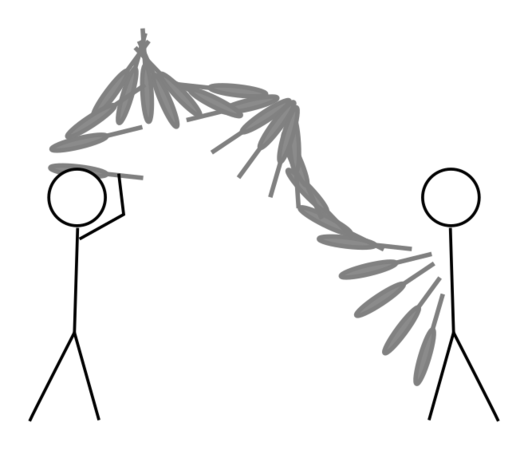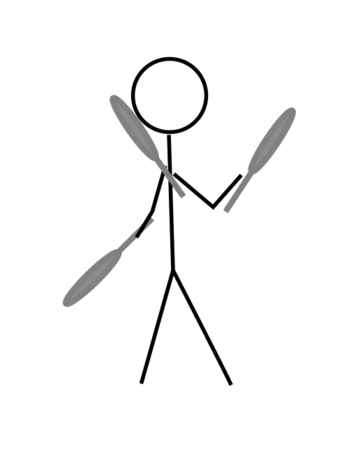From jugglingpatterns
Content deleted Content added
No edit summary |
No edit summary |
||
| (8 intermediate revisions by the same user not shown) | |||
| Line 6: | Line 6: | ||
The beginnings (mostly) use only one throw type. When that throw has been practiced in different patterns, we start mixing different throw types. |
The beginnings (mostly) use only one throw type. When that throw has been practiced in different patterns, we start mixing different throw types. |
||
== Entry Patterns == |
|||
These patterns are suitable for beginners. It helps a lot if one juggler is more experienced. All patterns only use one throw type (on the beginner side). |
|||
<!-- == Theory == |
|||
<gallery heights=300px widths=400px mode="packed-overlay"> <!--mode="packed-hover"--> |
|||
a.k.a "what do all the numbers mean" |
|||
image:one-zap2.png | link=Beginning Zaps | <font size=+1> Beginning Zaps</font> |
|||
image:one-pass-notext.png | link=Beginning Single Passes | <font size=+1> Beginning Single Passes</font> |
|||
image:selfs.png | link=Beginning Selfs - Juggling 3 Clubs| <font size=+1> Juggling 3 Clubs Alone</font> |
|||
</gallery> |
|||
Most patterns can be described best by a juggling math called [[Siteswap]], and from that it is possible to do animations and tell passers what they have to do and how they have to start the pattern. You don't need to know how this works to juggle the patterns, but you will constantly see traces of the theory being used throughout the pages and at some point understanding will be helpful. This is described here: |
|||
* Entry point [[Siteswap]] |
|||
--> |
|||
<!-- == Before All Else == |
<!-- == Before All Else == |
||
| Line 20: | Line 23: | ||
* [[ First Tricks with 3 balls]] |
* [[ First Tricks with 3 balls]] |
||
--> |
--> |
||
== Entry Patterns == |
|||
These patterns are suitable for beginners. It helps a lot if one juggler is experienced. |
|||
* [[Beginning Zaps]] |
|||
[[image:one-zap2.png|thumb|upright=0.5|Zaps]] |
|||
* [[Beginning Single Passes]] |
|||
[[image:throwing-a-pass.png|thumb|upright=0.5]] |
|||
* [[Beginning Selfs - Juggling 3 Clubs]] |
|||
== "Selfless Passing" (Zips and Passes) == |
== "Selfless Passing" (Zips and Passes) == |
||
[[Selfless Passing ]] |
|||
<gallery heights=300px widths=400px mode="packed-overlay" align="left"> <!--mode="packed-hover"--> |
|||
* [[ inverted parsnip ]] - 4 clubs - PZZPZ |
|||
image:one-pass-notext.png | link=Selfless Passing| <font size=+1>Selfless Passing<br> Goal: 7 club 1-count</font> |
|||
* [[ parsnip ]] - 5 clubs - PPZPZ |
|||
</gallery> |
|||
* [[The ugly brother of parsnip - 77272]] - 5 clubs - PPPZZ |
|||
* [[ PPPPZ ]] - 6 clubs |
|||
* [[ 7-club 1-count ]] |
|||
== Unfinished == |
|||
== Training Patterns Selfs and any kind of pass (zap, single pass, double pass) == |
|||
[[Todo]] main page overview of unwritten pages |
|||
* [[ 5-club 4-count]] |
|||
* [[ 5-club 3-count]] |
|||
* [[ 5-club 2-count ]] |
|||
== Zaps and Selfs == |
|||
[[5-club 2-counts with zaps]] (dead bunny and killer bunny) |
|||
Asyncronous patterns resembling n-count for each juggler. One throws passes, the other throws zaps. They are not very nice patterns, hence the name: |
|||
* [[The Ugly-counts]] |
|||
This is a good "real" start into patterns with zaps and selfs, because the zip-self can just be substituted with doing nothing. |
|||
* [[zap-self-zip-self-self 56662]] |
|||
The next patterns already mix high selfs and low zaps: |
|||
* [[75666 pass,self,self,zap,self]] |
|||
* [[7566666 pass,self,self,self,zap,self,self]] |
|||
== Single Passes and Selfs == |
|||
'''6 club Half-Synchronous patterns''' (right hand of both jugglers throws at the same time), a.k.a "normal passing": |
|||
* [[6-club 4-count]] |
|||
* [[6-club 3-count]] |
|||
* [[6-club 2-count]] |
|||
* [[6-club 1-count]] |
|||
* [[6-club PPS - Pass Pass Self ]] |
|||
* [[6-club Chocolate bar - PPSS]] |
|||
* [[6-club Vanilla bar - PSSP]] |
|||
"Jim's" version of those patterns: |
|||
* [[6-club Jim's 4-count]] |
|||
* [[6-club Jim's 3-count]] |
|||
* [[6-club Jim's 2-count - 77466]] |
|||
* [[6-club Jim's 1-count]] |
|||
* [[6-club Jim's PPS]] |
|||
== Double Passes == |
|||
* [[early double]] - in 4-count, 3-count, 2-count, etc? |
|||
* [[late double]] - in 4-count, 3-count, 2-count |
|||
* [[ Throwing the first double passes ]] - self-pass |
|||
* [[pass-self vs dpass-zip 7962]] |
|||
* [[doublepass-zip]] <4p|1><1|4p> |
|||
* dpass self zip self zip - 96622 |
|||
* PZPZPZZ (doubles) - 9229922 |
|||
== Heffs in Solo Patterns - 4 club exercises == |
|||
Recommended solo-patterns before you start: |
|||
* [[solo 423]] |
|||
* [[solo 40]] - two clubs in one hand with doubles |
|||
* [[solo 441]] |
|||
* [[solo 4 clubs with doubles]] |
|||
== [[Heff]]s in Passing Patterns == |
|||
Tricks, typically done in 4-count, 3-count, etc. |
|||
* [[441 heff,heff,zip in 4-count]] |
|||
* [[heff,hold in 3-count]] |
|||
* [[heff,hold in 4-count]] |
|||
* [[heff,zap in 4-count]] |
|||
First patterns with a heff - 5 club why nots |
|||
* [[5c why-not]] |
|||
* [[5c not-why]] |
|||
The why not family - 6 clubs: |
|||
* [[Why not]] |
|||
* [[Not why]] |
|||
* [[Maybe]] |
|||
* [[Not likely]] |
|||
* [[Only Sunday with good weather]] |
|||
7 club why nots: |
|||
* [[7 club why-not 9968926]] |
|||
* [[7 club not-why 9689962]] |
|||
== Double Selfs in Solo Patterns // Learning the 5 Ball Cascade == |
|||
The "normal" 5 club cascade is juggled with double selfs. Usually long before that you learn to juggle 5 balls. |
|||
The patterns for practicing double selfs and for preparing you for each 5-object pattern are mostly the same. |
|||
* [[Shower 51]] |
|||
* [[Snake 505050]] |
|||
* [[Solo 552]] |
|||
* [[Solo 5551]] |
|||
* [[Solo 55550]] |
|||
== Triple Selfs in Solo Patterns == |
|||
*[[solo 531]] |
|||
*[[solo 534]] |
|||
== Popcorns (Heffs or Triple selfs) == |
|||
* [[6-count popcorn]] |
|||
* [[5-count popcorn - 78686]] |
|||
* [[sync 5-count popcorn]] |
|||
== Doubles vs Passes == |
|||
* [[ Dpass,Self vs. Pass,Zip - 7926 ]] |
|||
* [[DP DP Z DP ZZ vs. P Z Z P P Z - 979222972722]] |
|||
* [[DP DP DP DP DP DP Z vs. P P Z P P P]] |
|||
== Here Be Dragons - The Quest for the Holy Grail == |
|||
A dragon is a double pass followed by a zap. They both arrive at the same hand, the zap first. |
|||
* [[92522]] |
|||
* [[baby dragon 756]] |
|||
* [[dragon - black beast of aaaarg - 945]] |
|||
* [[dragon cat - 95524]] |
|||
* [[97522]] |
|||
* [[Holy Grail - 975]] |
|||
<!-- |
|||
The purpose of this wiki is to help you find the 1-3 new juggling patterns or tricks, that you want to try next. There are many resources on juggling patterns available on the net, but I often found myself overwhelmed by a long list of patterns of varying difficulty without a clear indicator on what single pattern to try out. |
|||
== Difficulty == |
|||
There is often no clear difficulty comparison between two patterns, because there is more than one type of difficulty in juggling. One can imagine them as difficulty dimensions - like axes on a coordinate system. A pattern can be easier than another one on one axis, but more difficult on another. |
|||
Types of difficulties include: |
|||
* height of throws |
|||
** number of high throws |
|||
** difference in height between highest and lowest throw |
|||
* length and/or complexity of sequence |
|||
Things that push your level back towards beginner: |
|||
* different object to juggle (ball vs club vs ring) |
|||
* different type of throws (crossed arms/mills mess, body throws in pattern) |
|||
== 1 Juggler == |
|||
[[learning the 3 ball cascade]] |
|||
[[first steps after 3 ball cascade]] |
|||
[[goal 4 ball fountain]] |
|||
[[goal 5 ball cascade]] |
|||
== 2 Jugglers == |
|||
* [[goal 7 club 1-count]]: parsnip series |
|||
* [[why nots]] |
|||
* [[ half-synchronous n-counts ]] 4 count and friends |
|||
* [[list of asymmetric passing patterns]] patterns with different difficulty for both passers |
|||
== 3 Jugglers == |
|||
== 4 Jugglers == |
|||
== 5 Jugglers == |
|||
== 6 Jugglers == |
|||
== N Jugglers == |
|||
--> |
|||
Latest revision as of 16:32, 14 September 2022
The goal of this wiki is to offer "learning paths", of similar patterns with increasing difficulty.
There are different types of difficulty, so there is more than one starting point for each type of throw. Entry points with no/little experience all start with "Beginning with"
The beginnings (mostly) use only one throw type. When that throw has been practiced in different patterns, we start mixing different throw types.
Entry Patterns
These patterns are suitable for beginners. It helps a lot if one juggler is more experienced. All patterns only use one throw type (on the beginner side).
"Selfless Passing" (Zips and Passes)
Unfinished
Todo main page overview of unwritten pages


